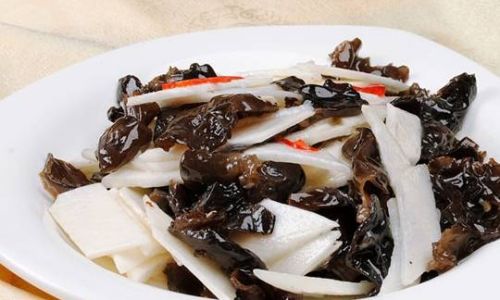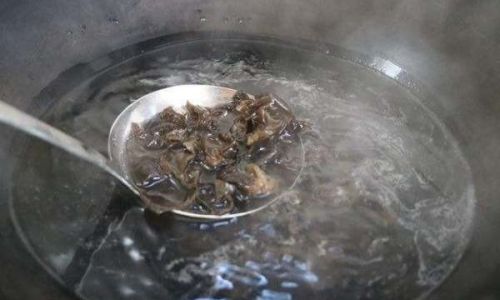Introduction
Stir-fried black fungus, a staple in Asian cuisine, is celebrated for its unique texture, earthy flavor, and impressive nutritional profile. Often referred to as “cloud ears” or “wood ear mushrooms,” this ingredient transforms simple dishes into culinary delights. However, achieving the ideal balance between tender crispness and overcooked rubberiness hinges on precise timing. Many home cooks and even seasoned chefs grapple with the question: How many minutes does it take to cook stir-fried black fungus to perfection? This article delves into the science and art of cooking this versatile ingredient, exploring factors that influence cooking time, step-by-step techniques, and expert tips to elevate your dish.
The Basics of Black Fungus
Black fungus (Auricularia auricula-judae) is a gelatinous, edible mushroom native to Asia and Pacific regions. Dried black fungus is commonly sold in packages and requires rehydration before use. Its ability to absorb flavors and retain a satisfying chew makes it a favorite in stir-fries, salads, and soups. Nutritionally, it is low in calories but rich in dietary fiber, antioxidants, and iron, making it a healthy addition to meals.
Preparation: The Foundation of Perfect Cooking
Before even lighting the stove, proper preparation is critical. Dried black fungus must be soaked in warm water for 20–30 minutes until fully hydrated. Rushing this step results in uneven cooking and a gritty texture. Once rehydrated, rinse the fungus thoroughly to remove any residual debris. Tear it into bite-sized pieces or slice it into strips, depending on the recipe. Smaller pieces cook faster, so adjust accordingly if time is a constraint.
The Cooking Process: Timing Is Key
The golden rule for stir-fried black fungus is 3–5 minutes over high heat. This window ensures the fungus softens without losing its characteristic snap. However, several variables can shift this timeline:
- Heat Intensity: A blazing-hot wok or skillet sears the fungus quickly, locking in moisture. Medium heat prolongs cooking, risking sogginess.
- Quantity: Overcrowding the pan lowers the temperature and steams the fungus instead of stir-frying it. Cook in batches if necessary.
- Add-Ins: Ingredients like vegetables, meat, or sauces alter cooking dynamics. Delicate vegetables (e.g., spinach) wilt rapidly, while heartier ones (e.g., carrots) need pre-cooking.
Step-by-Step Guide to Stir-Fried Black Fungus

-
Preheat the Wok: Heat 2–3 tablespoons of oil (peanut, vegetable, or sesame) in a wok over high heat until it shimmers. A well-seasoned carbon-steel wok distributes heat evenly, crucial for achieving wok hei—the coveted smoky aroma.
-
Aromatics First: Toss in minced garlic, ginger, or sliced chili peppers. Sauté for 15–20 seconds until fragrant but not browned. Burnt aromatics impart bitterness, so vigilance is key.
-
Add the Black Fungus: Introduce the prepared fungus to the wok. Stir vigorously to coat each piece in oil. The high heat will initiate sizzling, a sign of proper searing.
-
Stir-Fry Technique: Use a spatula or wok ladle to toss the fungus continuously. This motion prevents burning and ensures even cooking. After 2 minutes, the fungus will begin to soften and shrink slightly.
-
Season and Flavor: At the 3-minute mark, add seasonings like soy sauce, oyster sauce, or a pinch of sugar. Toss to combine. For added depth, splash a tablespoon of rice wine or Shaoxing wine.
-
Final Touches: If the recipe calls for vegetables (e.g., bell peppers, snow peas) or proteins (e.g., tofu, chicken), add them now. Stir-fry for an additional 1–2 minutes until tender.
-
Test for Doneness: Pierce a piece of fungus with a fork. It should yield slightly but retain resistance—a texture described as “al dente.” Overcooked fungus becomes slimy and loses its appeal.

-
Serve Immediately: Transfer to a plate to halt cooking. Garnish with sesame seeds, cilantro, or sliced scallions for visual and textural contrast.
Factors Influencing Cooking Time
- Thickness of Slices: Thicker strips require an extra minute, while shredded fungus cooks in 2–3 minutes.
- Altitude: At high elevations, water boils at lower temperatures, potentially extending cooking time.
- Pan Material: Cast-iron pans retain heat longer than stainless steel, affecting searing speed.
- Desired Texture: Some prefer a firmer bite (3 minutes), while others enjoy a softer consistency (4–5 minutes).
Common Mistakes to Avoid
- Overcrowding the Pan: This lowers the wok’s temperature, leading to steaming instead of stir-frying.
- Under-Soaking Dried Fungus: Incompletely hydrated fungus remains tough even after cooking.
- Adding Liquid Too Early: Sauces or water introduced prematurely create steam, softening the fungus excessively.
- Neglecting Constant Stirring: Stagnant fungus sticks to the pan and chars.
Health Benefits and Culinary Versatility
Beyond its culinary appeal, black fungus offers remarkable health benefits. Studies suggest it may support heart health, boost immunity, and aid digestion due to its high fiber content. Its neutral flavor makes it a canvas for bold seasonings, from spicy Sichuan sauces to subtle garlic-infused oils.
Advanced Techniques for Enthusiasts
- Velveting Protein: Marinate meats in cornstarch and baking soda for tender results before adding to the wok.
- Double-Cooking Method: Blanch the fungus briefly in boiling water to jumpstart cooking, then stir-fry for texture contrast.
- Smoky Infusion: Finish the dish with a drizzle of chili oil or a sprinkle of smoked paprika for complexity.
Conclusion
Mastering the cooking time for stir-fried black fungus is a blend of science and intuition. While 3–5 minutes serves as a reliable guideline, adapting to your stove’s idiosyncrasies and recipe requirements is essential. Remember that practice breeds perfection—experiment with heat levels, add-ins, and seasonings to discover your signature style. Whether paired with crisp vegetables, succulent meats, or a simple soy-ginger glaze, perfectly cooked black fungus elevates any meal. So, fire up the wok, embrace the sizzle, and savor the delightful dance of textures and flavors that this humble ingredient offers.





0 comments